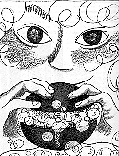


|
It's Elementary!
Investigating the Chemical World
Douglas Hayward and Gordon S. Bates. Illustrated by Nyla Sunga.
Subject Heading:
Grades 4 - 8 / Ages 9 - 13.
|
excerpt:
Over 200 years ago, a French chemist named Antoine Lavoisier was the first to measure the percentage of oxygen in air. You can repeat his experiment using simple materials from the kitchen.
Use a knife and a fork to pack a pad of steel wool into the bottom of a clear jar or glass. Avoid touching the sharp steel wool with your bare fingers. Rinse the steel wool thoroughly with tap water and then invert the jar in a pan or bowl full of water. If the jar will not stand up or starts to float, remove some of the water.
 It's Elementary! is the kind of book teachers, parents
and kids love. It is educational, well written, and interestingly
illustrated. It introduces young enquiring minds to basic scientific
principles through a large number of experiments. The experiments are
conducted with materials that really are available in most homes, or are
easily attainable. The instructions are clear and stress safety, although
none of the included experiments really have potential for accidents.
It's Elementary! is the kind of book teachers, parents
and kids love. It is educational, well written, and interestingly
illustrated. It introduces young enquiring minds to basic scientific
principles through a large number of experiments. The experiments are
conducted with materials that really are available in most homes, or are
easily attainable. The instructions are clear and stress safety, although
none of the included experiments really have potential for accidents.

Recommended.
Harriet Zaidman is a Winnipeg teacher/librarian.
To comment on this title or this review, send mail to cmeditor@mts.net
![]()
Copyright © 1995 the Manitoba Library Association.
Reproduction for personal use is permitted only if this copyright notice
is maintained. Any other reproduction is prohibited without permission.
Published by
The Manitoba Library Association
ISSN 1201-9364
 Go back to CM Welcome page
Go back to CM Welcome page
 Go back to Table of
Contents for this Issue
Go back to Table of
Contents for this Issue